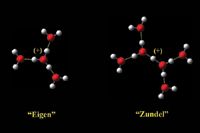
- Spectroscopy-01-01-2006
- Volume 21
- Issue 1
End of the Spectrum: Studying Water One Molecule at a Time
Chemists use spectroscopy to understand the unusual chemical behavior of water at the molecular level.


We have known for two centuries that water is a simple molecule—two hydrogen atoms and one oxygen atom. But it doesn't behave as straightforward as it looks. In the company of others of its kind, this molecule becomes surprisingly flexible and elastic, and changes dramatically, influenced by its neighboring molecules. This complex behavior has confounded scientists for decades.
"You can't say, 'Well, I know exactly how these two water molecules stick together and now I'll make a liquid by sticking a whole bunch of them together'," says Mark Johnson, professor of chemistry at Yale University (New Haven, CT). "That doesn't work...the molecule five water molecules away is affecting the properties of the [one that you are] focusing on. That has raised havoc with trying to get simple models to work to get all the properties [of water] right."


Models show a proton bound to one water molecule (Eigen model) or shared between two molecules (Zundel model).
To elucidate the chemical nature of water, Johnson and his research group are starting at the bottom, studying the interactions of just ten or so water molecules. They use a technique called argon nanomatrix spectroscopy to observe chemical processes at the molecular level in the form of energy patterns. They are studying how charge gets transported in a cluster of a few molecules, and have shown that placing a proton in the cluster changes its fundamental arrangement as the molecules cooperate to accommodate the charge.
Proton transport in a few molecules is important in many biological phenomena. In vision, for instance, protons have to be transported through membranes in order to register that light struck the optical receptor cells. About half a dozen water molecules mediate this transport. "And that's not uncommon [in biological processes]," says Johnson. "There's always a little bit of water that's doing important stuff, it's not there by accident." These few molecules behave very differently than bulk water, which has been studied well in the past.
The Yale chemists start with a small number of frozen water molecules—sometimes just one—add a proton, and then measure the changes in the infrared absorption that occur as more molecules are added one by one to the tiny ice crystals. The researchers observe that when the proton is associated with one molecule, as hydronium or H3O+ , it "gives a pretty nice spectrum and it is the highest energy vibration you're going to get," Johnson says. This is because the charge is spread over three hydrogen atoms.


Mark Johnson, holding a model of water molecules, with graduate students Eric Diken, Joseph Roscioli, and Joesph Bopp.
As the hydronium interacts with the increasing number of molecules surrounding it, the proton can get more localized on two or just one of the hydrogen atoms. The energy correspondingly shifts, becoming lowest when the proton is in the act of transport between two waters and all the charge is on one atom. "So the frequencies in the spectrum are directly mapping how much the extra charge is localizing on three, two or one proton," he says.
Nanomatrix spectroscopy, the tool that Johnson's group uses to obtain the energy spectra of the frozen water cluster, was discovered by Nobel Prize-winner Yuan T. Lee and his then graduate student Michio Okumura at the University of California, Berkeley (Berkeley, CA) in the late 1980s. In this technique, researchers attach a rare gas atom such as argon to a molecule they want to study. Then they excite the molecule with infrared light, and at the resonance frequency, the argon atom falls off. From the observed frequency pattern, the researchers can deduce the molecule's structure.
Johnson's group has been able to use this method to study clusters of up to 15 water molecules. They are trying to push that limit in order to understand how things work as the crystals grow towards bulk ice. The American Physical Society will give Johnson the Earle K. Plyler Prize for Molecular Spectroscopy at the APS March 2006 meeting in Baltimore, MD for his studies published in Science in 2004.
Prachi Patel-Predd
Assistant Editor, Spectroscopy
Articles in this issue
almost 20 years ago
Efficient Raman Lasing in Tapered Silicon Waveguidesalmost 20 years ago
Linearity in Calibration: Quantifying Nonlinearity, Part IIalmost 20 years ago
Linearity Jan 06almost 20 years ago
Efficient Raman Jan 06almost 20 years ago
Mars Express Finds Evidence of Liquid Water on Marsalmost 20 years ago
Modulatorsalmost 20 years ago
Efficient Raman Lasing in Tapered Silicon Waveguides (PDF)Newsletter
Get essential updates on the latest spectroscopy technologies, regulatory standards, and best practices—subscribe today to Spectroscopy.




